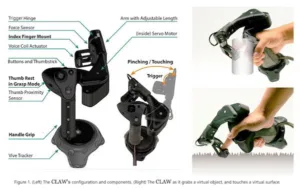In a recent article on the Microsoft Research Blog, Microsoft described an array of haptic controllers that can be used to enhance the experience in a virtual reality environment.
In the current state, these controllers are pure research objects and is not clear if any of these ideas will ever make to to the real world. There are YouTube videos available and linked for all systems mentioned below.
The Claw – is a VR and haptic feedback controller rolled into one. It allows the user to grasp objects or gives feedback by not allowing the user to penetrate virtual objects. Once grasped, the controller can simulate different materials like hard boxes or soft sponges by varying the resistance of compressing them. A vibration element under the index finger can simulate the surface texture of various surfaces. The system can also simulate the recoil of a handgun, a function that will most likely add another dimension to gaming and visualization systems.
Microsoft Haptic Controller
The Haptic Revolver – is a revolving wheel that allows the user to experience detailed tactile feedback by rotating a part of the wheel under the finger that contains the corresponding surface. The exchangeable wheels allow experiencing a wide array of textures. By altering the rotation speed the system can create friction with the finger running over a virtual surface.
Haptic Links – couples two virtual reality controllers via a series of joints with controllable friction. There are several version of this system presented that can simulate weapons like guns, spears and bows or also things like steering wheels or handle bars on a motorcycle. This system is most likely aimed at enhanced game controllers by giving a more realistic experience during game play.
The Canetroller – is a device that simulates a cane for visual impaired. It gives the user similar feedback as a real cane. The cane is attached to the person via a slider allowing to create a force similar to the cane actually touching a real world object. In addition there is a voice coil creating an audible feedback when the controller hits a virtual object. This allows the visual impaired to join in into the virtual world or train people losing their vision on using their cane cane.
Analyst Comment
This shows that Microsoft spends significant resources on the VR concept. While these devices are pure R&D at this point in time, one could see some of these concepts being introduced in the future to create an even more immersive environment. In some cases there maybe industrial or medical applications that could benefit from such systems. (NH)

